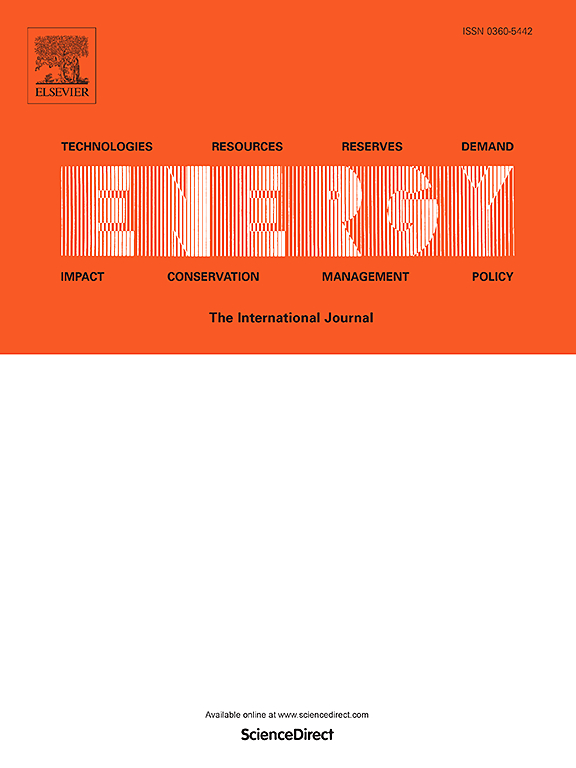嵌入式微通道的协同热液优化:平衡芯片冷却效率和抗压力波动
IF 9
1区 工程技术
Q1 ENERGY & FUELS
引用次数: 0
摘要
嵌入式微通道冷却技术通过实现冷却剂与发热芯片之间的直接接触,显著降低了热阻,与传统方法相比,具有无与伦比的冷却效果。然而,冷却剂和热源之间的直接接触导致芯片上更显着的温度波动和微通道中的压力灵敏度增加。这些因素已成为制约系统能效进一步提高的关键因素。本文提出了一种易于植入且具有良好散热性能的嵌入式芯片冷却系统。一种带二次通道的嵌入式微通道翼型空腔针翅扰流片结构(EMAT-SC),旨在进一步增强嵌入式微通道冷却的换热能力,同时保证嵌入式冷却系统的稳定性。通过数值模拟方法确定,当二次通道相对宽度(α)约为0.47,扰流片结构相对尺寸(β)在0.28 ~ 0.56范围内时,EMAT-SC可以获得最佳的散热性能。在此基础上,我们进一步将EMAT-SC的冷却性能与矩形结构的嵌入式微通道(EMRR)、三角形肋槽结构的嵌入式微通道(EMTR)和传统二次通道结构的嵌入式微通道(EMSC)进行了比较。结果表明,EMAT-SC不仅可以保持与EMTR相当的Δp传热性能,而且具有优越的传热性能。EMAT-SC的性能评价指标(PEC)在Re = 783时达到1.50,与近年来同规模的优化方案相比,综合热性能最佳。本研究为针对高热流密度电子设备的嵌入式冷却系统解决方案,特别是嵌入式微通道的协同热水力优化提供了有价值的见解和参考。本文章由计算机程序翻译,如有差异,请以英文原文为准。
Synergistic thermo-hydraulic optimization of embedded microchannels: Balancing chip cooling efficiency and pressure fluctuation resistance
Embedded microchannels cooling technology significantly reduces thermal resistance by enabling direct contact between the coolant and the heat-generating chip, exhibiting an incomparable cooling effect compared to traditional methods. However, direct contact between the coolant and the heat source results in more significant temperature fluctuations on chip and increased pressure sensitivity in the microchannel. These factors have become key factors restricting further improvement of the system's energy efficiency. This paper proposes an embedded chip cooling system that is easy to implant with great thermal performance. An embedded microchannels with secondary channels of airfoil cavity pin-fin spoiler structure (EMAT-SC), designed to further enhance the heat transfer capabilities of embedded microchannels cooling while ensuring the stability of the embedded cooling system. Through numerical simulation methods, it is determined that EMAT-SC can obtain the best heat dissipation performance when the relative width of secondary channel (α) is about 0.47 and the relative size of spoiler structure (β) is in the range of 0.28–0.56. Based on these findings, we further compared the cooling performance of the EMAT-SC with that of the embedded microchannels with rectangular structure (EMRR), the embedded microchannels with triangular rib groove structure (EMTR), and the embedded microchannels with conventional secondary channels structure (EMSC). The results confirm that EMAT-SC can not only maintain a Δp comparable to that of EMTR, but also exhibits superior heat transfer performance. The performance evaluation criterion (PEC) of EMAT-SC reaches 1.50 at Re = 783, which shows the best comprehensive thermal performance compared with the optimization schemes of the same size in recent years. This study offers valuable insights and serves as a reference for embedded cooling system solutions aimed at high heat flux density electronic equipment, particularly in synergistic thermo-hydraulic optimization of embedded microchannels.
求助全文
通过发布文献求助,成功后即可免费获取论文全文。
去求助
来源期刊

Energy
工程技术-能源与燃料
CiteScore
15.30
自引率
14.40%
发文量
0
审稿时长
14.2 weeks
期刊介绍:
Energy is a multidisciplinary, international journal that publishes research and analysis in the field of energy engineering. Our aim is to become a leading peer-reviewed platform and a trusted source of information for energy-related topics.
The journal covers a range of areas including mechanical engineering, thermal sciences, and energy analysis. We are particularly interested in research on energy modelling, prediction, integrated energy systems, planning, and management.
Additionally, we welcome papers on energy conservation, efficiency, biomass and bioenergy, renewable energy, electricity supply and demand, energy storage, buildings, and economic and policy issues. These topics should align with our broader multidisciplinary focus.
 求助内容:
求助内容: 应助结果提醒方式:
应助结果提醒方式:


